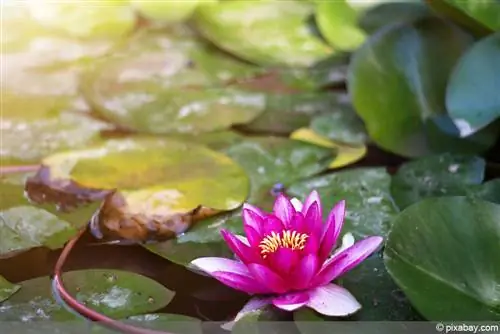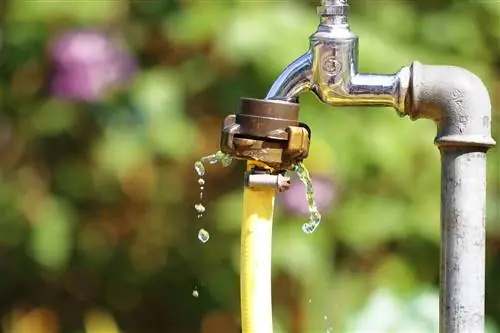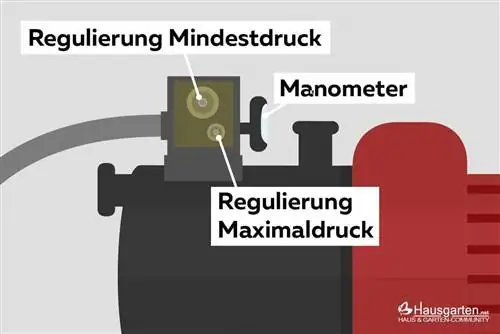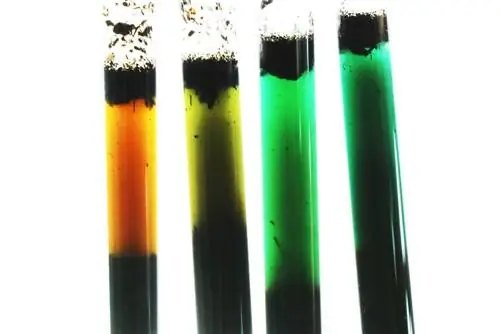- Author admin [email protected].
- Public 2023-12-17 03:39.
- Last modified 2025-01-24 12:45.
Anyone who owns a garden pond should keep an eye on its most important water parameters, because the garden pond system can only function properly if they are in order. The water quality depends in particular on the carbonate hardness and the pH value, i.e. the acidity of the water. Fluctuations in these values can be life-threatening for pond inhabitants. Consequently, determining the most important water parameters should be the main component of pond care.
What describes carbonate hardness?
Ponds are among the most species-rich biotopes that provide habitat for numerous animals and plants. Carbonate hardness is an important parameter for long-term good water quality. It describes the concentration of dissolved minerals, especially calcium and magnesium, and is an important value for the buffering capacity of the pond water. The main thing is how well the water can absorb fluctuations in the pH value. It makes no difference whether it is a pure garden pond or a koi pond, because water behaves the same in both types of ponds.
Ponds tend to become acidic after a certain period of time. The buffering effect of the carbonates can absorb these acids and thus counteract a drop in the pH value, a so-called acid fall. Excessive algae growth can be subject to large fluctuations in pH from one day to the next, so measures must be taken to increase or decrease it accordingly.
The carbonate hardness value (KH value) is given in º dH (degree of German hardness) and is ideally between 6º and 8º dH. The higher the value, the more stable the pH value of the water is. In addition to the carbonate hardness, the overall hardness of the minerals dissolved in the pond water is always crucial. If the overall hardness is too soft, the biological processes in the pond stagnate. That's why you should always measure both values and keep an eye on them constantly.
Reduce carbonate hardness value in the pond
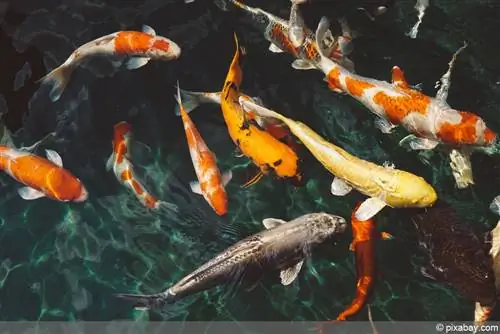
If many dissolved minerals get into the pond water, be it through various pond care products or rocks containing minerals, the carbonate hardness value (KH value) in the water increases. However, countless microorganisms in the water absorb minerals, so that a KH value in pond water that is too high is rather rare. This value is too high if it is over 18 º dH.
An associated too high pH value means that ammonium contained in the water can convert into dangerous ammonia. To counteract this from the outset, you should not use tap water that contains a lot of lime to fill a garden pond, but rather use well water or treated rainwater. If it is actually necessary to lower the KH value, there are several options:
- Reduce carbonate hardness by softening the pond water
- Add soft water to the pond
- Do a partial or complete water change
- Prolonged or frequent rainfall can compensate for excessive carbonate levels
- Reduction of carbonate hardness, leads to a simultaneous reduction of the pH value
- Softening, also possible by using strong UVC lamps
- UV light softens the water
- Make sure to use low wattage when using UVC lamps to keep electricity costs down
- Use of these lamps is only recommended if there is a good filter system
Occasionally it is recommended to use peat as a water softener, but this usually does not make sense because peat releases acids into the water, thereby lowering the pH value and thus only simulates actual softening. If you still want to try it, you should change the peat regularly.
Tip:
What you should definitely not do is discharge untreated rainwater, for example from the gutter, into the pond. Bird droppings, algae, pollutants and much more would be washed into the pond, which in turn can seriously disrupt the balance in the pond.
Increase KH value if it is too low
If the carbonate hardness is exactly 5 º dH or below, for example in newly created or stagnant waters, appropriate measures must be taken to increase it as quickly as possible. If the hardness level is too low, this leads to fluctuations in the pH value and it becomes unstable. Constant rainfall is often responsible for this.
The cause can also be water changes that have not been carried out for a long time or the complete avoidance of them. This means that the degree of hardness decreases more and more over time. Without occasional water changes or the addition of special products, carbonates cannot be added to the water. Carbonates can be added to water in different ways.
- Increase in carbonate hardness, which simultaneously increases the pH value
- Degree of increase should not exceed 1 º dH per day if possible
- To harden the water, e.g. add mussel greeting
- Also known from aquariums and consists predominantly of calcium carbonate (lime)
- Introduce mussel greetings into an existing stream or multi-chamber filter
- Calcium carbonate hardens the pond water slowly and continuously
- Limestones in streams have a similar effect
- Lower surface of the stones can only harden water slowly
- Specialist retailers also offer suitable means for adjusting the carbonate and total hardness
- With a higher carbonate hardness value, the pH value can also stabilize again
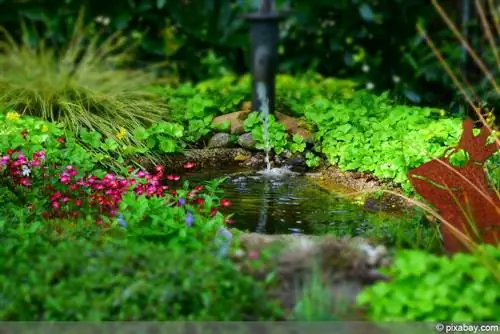
If possible, you should not discharge rainwater into a pond with a low KH value. It is far too soft and would actually worsen the water parameters. This is particularly evident in very rainy years, in increased algae growth. A KH value that is too low can trigger a real chain reaction, because if the pH value is too low, the nitrite content and thus the toxicity in the water increases. It is therefore better to use well or tap water if the carbonate hardness value is actually too low.
Tip:
A drastic drop in carbonate hardness can be counteracted with stabilizing water treatment products from specialist retailers or by changing the water.
Importance of carbonate hardness in pond water
As already mentioned, the carbonate hardness in the pond water is responsible for a stable pH value. Ideally, this should be between 7.5 and 8.5. The cleaner the water in the pond, the lower this value is. But what does a carbonate hardness value that is too high or too low mean and when is it optimally adjusted?
Less than 5 ºdH
If this value is below 5 ºdH, it is too low. This leads to fluctuations in the pH value and the toxicity of nitrite and ammonium increases. This value should be increased to at least 5 ºdH, which stabilizes the lime-carbonic acid balance.
Between 5 and 14 ºdH
The hardness of the pond water is optimally set at values between 5 and 14 ºdH, with a value around 10 being very good. The pH value is stable and the pond's natural self-cleaning function works, which also makes pond maintenance much easier.
Greater than 14 ºdH
A carbonate hardness of over 14 ºdH is too high, but this usually happens rather rarely. Pond technology such as pond pumps usually also suffers from a value that is too high. The degree of hardness can be reduced by introducing rain or well water.
Measure water values regularly
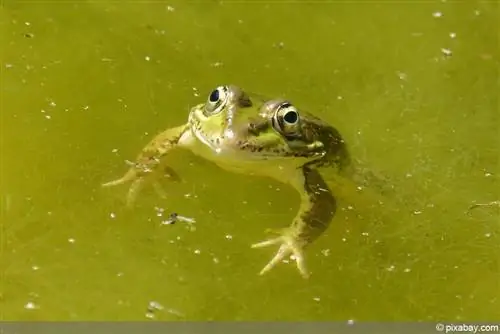
The life of plants and animals in the garden pond depends largely on the water quality. Garden ponds are generally not natural bodies of water and require appropriate care. The water values are determined by various factors, such as persistent rainfall, too high a fish population, too intensive or incorrect feeding, as well as incorrectly installed pond technology or water changes with unsuitable water.
The water in the garden pond is subject to corresponding fluctuations over the course of a day. Due to plants, algae and natural photosynthesis, the pH value can be rather high in the evening and significantly lower in the morning. Carbonate hardness continually decreases due to strong algae growth. This causes the pH value to become unstable. For these reasons, regular monitoring of the water values or their stabilization, especially the carbonate hardness and the overall hardness, is essential for a stable environment in the pond.
In order to be able to determine the water values safely and reliably, specialist retailers offer appropriate water tests. For quick measurements of the water parameters in between, there are special test strips or quick tests that provide exact values within a few seconds. So-called droplet tests are also suitable for weekly measurements.

